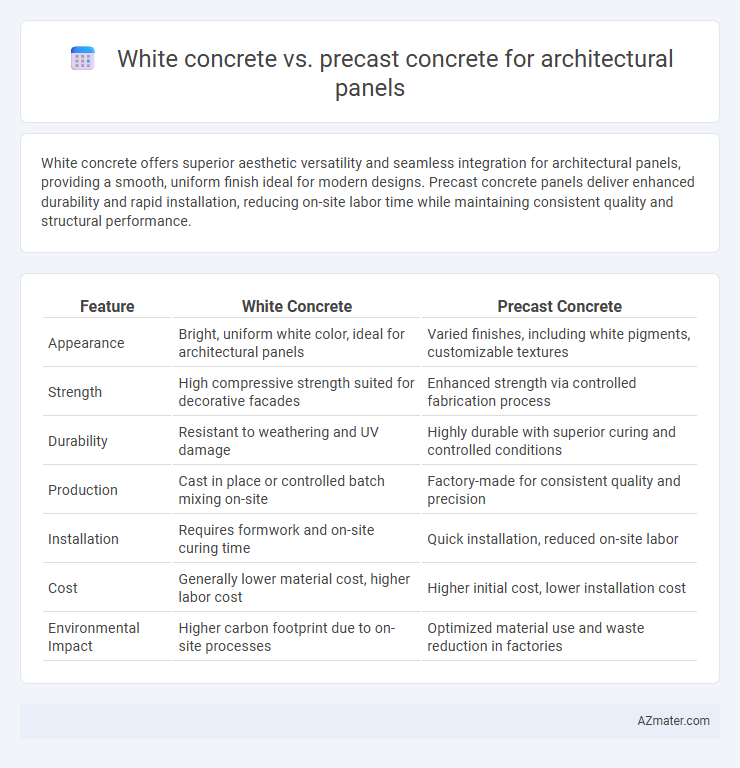White concrete offers superior aesthetic versatility and seamless integration for architectural panels, providing a smooth, uniform finish ideal for modern designs. Precast concrete panels deliver enhanced durability and rapid installation, reducing on-site labor time while maintaining consistent quality and structural performance.
Table of Comparison
| Feature | White Concrete | Precast Concrete |
|---|---|---|
| Appearance | Bright, uniform white color, ideal for architectural panels | Varied finishes, including white pigments, customizable textures |
| Strength | High compressive strength suited for decorative facades | Enhanced strength via controlled fabrication process |
| Durability | Resistant to weathering and UV damage | Highly durable with superior curing and controlled conditions |
| Production | Cast in place or controlled batch mixing on-site | Factory-made for consistent quality and precision |
| Installation | Requires formwork and on-site curing time | Quick installation, reduced on-site labor |
| Cost | Generally lower material cost, higher labor cost | Higher initial cost, lower installation cost |
| Environmental Impact | Higher carbon footprint due to on-site processes | Optimized material use and waste reduction in factories |
Introduction to Architectural Concrete Panels
Architectural concrete panels, often used for building facades, offer both aesthetic appeal and structural performance. White concrete panels provide a smooth, bright finish that enhances design flexibility and allows for intricate detailing, while precast concrete panels are manufactured in controlled environments ensuring consistent quality and faster installation. The choice between white concrete and precast concrete panels depends on project requirements such as color uniformity, texture, durability, and construction timeline.
What is White Concrete?
White concrete is a specialized form of concrete made using white Portland cement, white aggregates, and other light-colored components to achieve a bright, uniform appearance ideal for architectural panels. This material offers enhanced aesthetic appeal with smooth, clean surfaces and allows for greater design flexibility compared to traditional precast concrete, which often uses gray cement and darker aggregates. Its high reflectivity and color consistency make white concrete a preferred choice for decorative facades and modern architectural elements.
What is Precast Concrete?
Precast concrete is a construction material manufactured by casting concrete in reusable molds off-site, then transporting the cured panels to the construction location. This method allows for precise control of concrete quality, surface finish, and dimensions, which is ideal for architectural panels requiring uniformity and aesthetic appeal. Precast concrete panels offer enhanced durability, faster installation times, and reduced on-site labor compared to traditional white concrete poured and finished directly on-site.
Key Differences Between White Concrete and Precast Concrete Panels
White concrete panels offer superior aesthetic appeal with their bright, uniform appearance ideal for architectural facades, while precast concrete panels emphasize structural efficiency and faster installation through factory-controlled manufacturing. White concrete achieves its distinctive color through the use of white cement and light-colored aggregates, enhancing design flexibility for decorative applications, whereas precast panels prioritize durability and consistency in size and shape for load-bearing and thermal performance. Manufacturing processes for precast concrete involve casting in molds with reinforcement, allowing for complex shapes and embedded utilities, whereas white concrete panels focus more on surface finish and color quality for visual impact.
Aesthetic Qualities: Color, Texture, and Finish
White concrete offers a bright, clean aesthetic with a smooth finish that enhances modern architectural panels, providing excellent color consistency and a sleek appearance. Precast concrete allows for greater textural variety and intricate surface detailing, enabling customized finishes and diverse color options through pigments and coatings. Both materials deliver durable, visually appealing panels, with white concrete emphasizing uniformity and light reflectance, while precast concrete excels in tailored textures and design flexibility.
Structural Performance and Durability
White concrete offers superior aesthetic appeal with excellent color consistency, while precast concrete panels provide enhanced structural performance due to factory-controlled casting conditions ensuring uniform strength and density. Precast panels demonstrate higher durability through reduced permeability and improved resistance to environmental stressors like freeze-thaw cycles and chemical exposure. Both materials exhibit robust load-bearing capabilities, but precast concrete panels benefit from controlled curing methods that minimize internal defects, leading to longer service life in architectural applications.
Installation and Construction Methods
White concrete offers seamless, site-cast installation flexibility with customizable shapes and finishes, adapting well to complex architectural designs. Precast concrete panels enable faster construction timelines through factory-controlled quality and modular assembly, reducing on-site labor and minimizing weather-related delays. Both methods demand precise coordination, but precast panels typically require heavy lifting equipment, while white concrete installation emphasizes formwork and curing management.
Cost Comparison: White Concrete vs Precast Concrete
White concrete typically incurs higher initial costs due to specialized raw materials like white cement and pigments, while precast concrete benefits from mass production efficiencies, reducing overall expenses. Precast concrete panels also lower labor and installation costs because they are manufactured off-site under controlled conditions, enabling faster project completion. Long-term maintenance costs tend to be comparable, but the upfront budget impact often makes precast concrete a more cost-effective choice for architectural panel applications.
Sustainability and Environmental Impact
White concrete offers high reflectivity, reducing urban heat island effects and improving energy efficiency in buildings. Precast concrete panels typically use industrial waste byproducts like fly ash, lowering carbon footprint through material recycling and controlled production processes. Both materials provide durable options, yet precast concrete's factory-controlled environment enhances resource efficiency and reduces onsite waste, making it a sustainable choice for architectural panels.
Choosing the Right Panel for Your Architectural Project
White concrete offers exceptional aesthetic appeal with its bright, clean finish ideal for contemporary facades, while precast concrete panels provide superior quality control, faster installation, and enhanced durability due to factory production. Selecting the right architectural panel depends on your project's design requirements, budget constraints, and timeline, where white concrete excels in customization and visual impact, and precast panels reduce on-site labor and construction time. Consider environmental factors and maintenance needs, as white concrete may require more upkeep to preserve its appearance compared to precast panels, which are engineered for long-term performance.

Infographic: White concrete vs Precast concrete for Architectural panel
 azmater.com
azmater.com